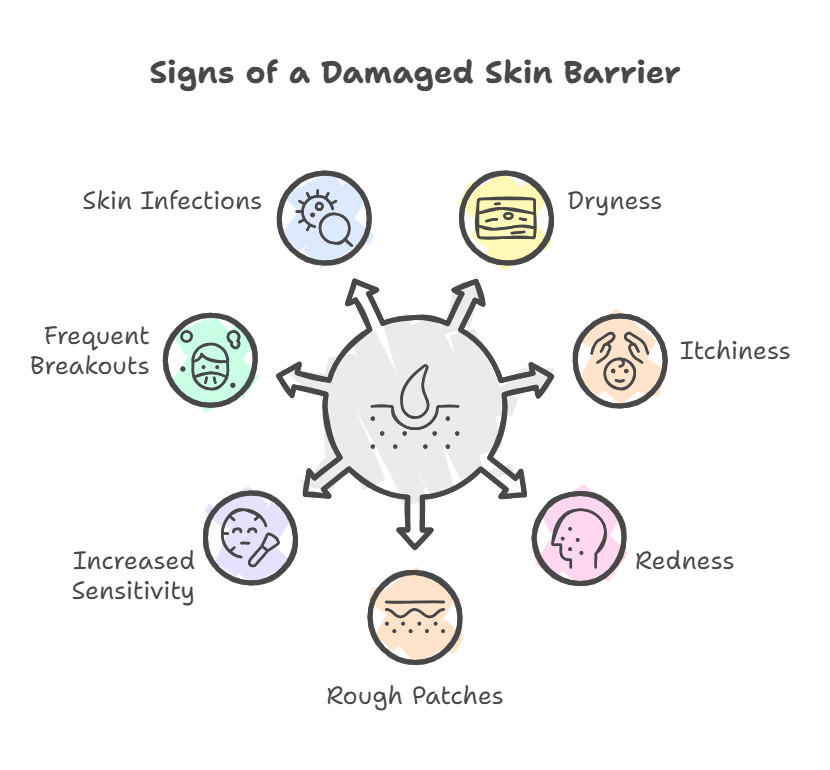Dealing with a damaged skin barrier can be incredibly frustrating. Dealing with constant itching and random breakouts feels like battling your own body.
This guide will help you fix a damaged skin barrier. We’ll explore everything. This includes common causes and symptoms. We’ll also cover ways to treat, repair, and prevent future damage.
What is a Damaged Skin Barrier?
Your skin’s outermost layer, the stratum corneum, acts as a shield, often described as a “brick wall.” These “bricks” are tough skin cells called corneocytes.
They are held together by a “mortar” made of ceramides, cholesterol, and fatty acids—forming your skin barrier. This complex structure locks in moisture and keeps irritants out, helping to prevent sensitivity. Learn more about skin restoration and barrier repair in our PRF under eyes guide.
What happens when this barrier is damaged? Your skin’s defenses have gaps. They let irritants in and cause moisture to evaporate. This leads to dryness, redness, breakouts, and increased sensitivity.
Recognizing the Damaged Skin Barrier Signs
How can you tell if your skin barrier is damaged? Look for these red flags:

- Dryness, even after moisturizing.
- Itchiness or burning sensations.
- Redness or inflammation.
- Rough or scaly patches, even flaky skin.
- Increased sensitivity to skincare products.
- Frequent breakouts or acne.
- Skin infections.
If you’re dealing with skin conditions like eczema, psoriasis, or acne, consult a dermatologist. They can assess your damaged skin barrier and provide personalized guidance1.
Common Culprits Behind a Damaged Skin Barrier
Several factors contribute to compromised skin. While age and genetics play a role, lifestyle and environmental elements often cause a damaged compromised skin barrier. Here are some common culprits:
- Over-washing or using harsh cleansers that strip your skin’s pH, removing natural oils.
- Over-exfoliating, creating micro-tears in the skin.
- Environmental factors, such as sun exposure, dry air, and pollution. Pollution, in particular, causes oxidative stress and inflammation, potentially leading to sun-damaged skin
- Certain medical conditions like eczema and contact dermatitis, or medications like steroids.
- Poor diet and lifestyle factors, including lack of sleep and stress. Chronic stress increases cortisol, leading to dehydration as explained by Harvard health experts2. A poor diet can also lead to dry skin.
Repairing Your Broken Skin Barrier: A Step-by-Step Guide
Repairing your damaged skin barrier requires patience and a consistent approach.
1. Gentle Cleansing
Use a mild, fragrance-free cleanser instead of harsh soaps, and wash with lukewarm water—hot water can strip natural oils and disrupt your skin’s acid mantle.
Look for ceramide-rich moisturizers and incorporate hyaluronic acid into your routine to soothe and hydrate the skin.”
Dr. Emma Craythorne
Maintaining a balanced skin pH (around 4.7) supports healthy bacteria, preserves the skin barrier, and protects against external aggressors. Learn more about skin regeneration and pH balance in our GHK-Cu guide.
Choosing the right cleanser is essential for maintaining healthy skin.
2. Hydrating and Moisturizing
Hydrating and moisturizing are crucial for restoring your skin barrier. Humectants, like hyaluronic acid or glycerin, attract moisture.
Seal in that moisture with an occlusive like petrolatum to create a protective layer. Apply moisturizer to damp skin, ideally after a warm shower, for optimal absorption3. Consistent moisturizing helps achieve soft, hydrated skin.
3. Replenishing and Strengthening
Plant oils, such as jojoba and sunflower, can soothe compromised skin. In this case, it’s important to incorporate pseudo-ceramides and fatty acids in skincare.
These ingredients mimic the composition of a healthy skin barrier. Ceramides, a crucial component of your skin’s natural “mortar,” can be particularly beneficial.
But finding a formula that combines these essentials without unnecessary fillers can be tricky. I came across La Roche-Posay Cicaplast Balm B5 UV, and it seems to check all the boxes—it’s packed with ceramides, fatty acids, and soothing ingredients to help restore the skin barrier. Might be worth a try if your skin needs extra support.
Using products with these ingredients can support your skin barrier function, improving your overall skin health.
4. Protection from Irritants
Protecting your damaged skin barrier from irritants is crucial for healing. Avoid harsh chemicals, excessive exfoliation, fragrances, and other potentially irritating skincare products.
Environmental factors, such as sun, smoking, wind, and cold weather, also contribute to barrier damage. Shielding your skin from these elements is essential.
Barrier creams can provide an extra layer of defense. Minimize irritation to allow your skin to heal.
Lifestyle Changes for a Healthier Skin Barrier
A healthy skin barrier isn’t just about skincare products. Diet, stress, and sleep play vital roles in your skin’s overall health and can contribute to skin barrier damage. Consider the information below for maintaining healthy skin.
| Factor | Impact | Recommendations |
|---|---|---|
| Diet | A healthy diet rich in fish oil and antioxidants can improve skin condition, especially by minimizing breakouts and blemishes. Consuming foods rich in essential fatty acids can significantly help with having skin soft, unlike sugary, processed foods that have an inflammatory effect. This article highlights the connection between diet and skin health4. | Eat foods like salmon, berries, spinach, and kale. Consider fish oil supplements and reduce your intake of sugary foods. |
| Stress | Stress hinders skin healing, exacerbates inflammation, worsens acne, and slows skin regeneration. Managing mental distress is important for overall well-being, including your skin. Managing stress effectively can positively impact skin health5, as chronic stress and its associated hormone fluctuations can contribute to skin barrier damage and hinder recovery from a damaged skin barrier. If you suffer from severe anxiety, consult a healthcare professional. | Practice stress-reducing activities such as yoga or deep breathing. Engage in regular physical activity such as exercise, which provides numerous physical and mental health benefits and supports healthy skin, especially during flare-ups. |
| Sleep | Insufficient sleep impedes skin repair and regeneration. It increases water loss, worsens signs of premature aging like wrinkles and fine lines, and heightens inflammation. Prioritizing enough sleep is important, as rest is crucial for repair. Getting 7-8 hours a night along with regular exercise and proper relaxation methods can significantly improve your skin’s ability to function well. Sleep deprivation impacts skin barrier function and its susceptibility to irritation and can negatively affect a damaged skin barrier. | Prioritize 7-8 hours of uninterrupted sleep nightly. Incorporate exercise, relaxation techniques (deep breaths, baths, yoga), and other healthy habits for improved sleep quality. |
Frequently Asked Questions
How to heal damaged skin barrier?
Repairing a damaged skin barrier involves gentle cleansing, moisturizing, and avoiding irritants. Use products containing ceramides, hyaluronic acid, and plant oils to help restore barrier function.
What does a damaged skin barrier look like?
A broken skin barrier often causes dry, itchy, red, and rough skin. It may also increase sensitivity and lead to breakouts or infections. Watch how your skin reacts to skincare products. Irritation could mean a damaged skin barrier.
How long does a damaged skin barrier take to heal?
Healing a damaged skin barrier can take weeks or months. The protein called filaggrin also plays a part. Be patient and consistent with your skincare routine for the duration of healing. It’s about improving overall skin health.
What does a severely damaged skin barrier look like?
A severely damaged skin barrier causes very dry, flaky, cracked skin. It also causes intense itching, redness, and inflammation. Open sores or infections might also occur. Treating dry skin and moisturizing factors can help repair a damaged skin barrier. Consulting with medical professionals is advisable for managing severe symptoms. Moisturizing is especially important.
Conclusion
A damaged skin barrier can significantly affect your comfort and confidence. You can treat and prevent it by knowing its causes and symptoms, and using proper skincare.
Lifestyle factors like diet, stress, and sleep affect your skin. They impact its health and function. Using skincare products with ceramides is key. They restore and protect your skin’s barrier.
We are working hard to promote healthy, glowing skin. This includes managing outside irritants and internal stress that can harm the skin. You want skin that can self regulate with the proper support. Skin barrier functions are about balance. Taking care of skin conditions is essential. Learn more about the skin barrier here.
Small Step, Big Impact
Consistency is key. Implementing a gentle skincare routine, protecting your skin from environmental stressors, and maintaining a healthy lifestyle can significantly improve your skin barrier over time.
Listen to this article
This is an AI generated Podcast version of the article.
- https://www.usdermatologypartners.com/blog/damaged-skin-barrier-signs[↩]
- https://www.paulaschoice.com.au/skin-care-advice/moisturizers/what-is-skin-barrier-and-why-it-matters[↩]
- https://www.webmd.com/skin-problems-and-treatments/skin-barrier-what-to-know[↩]
- https://www.paulaschoice.com/skin-care-advice/moisturizers/what-is-skin-barrier-and-why-it-matters[↩]
- https://losangeles-dermatologist.com/managing-stress-for-healthy-skin[↩]



